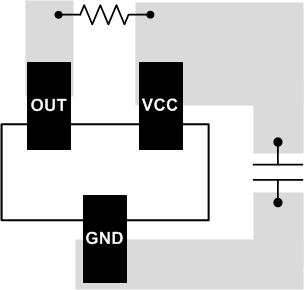SLIS152G May 2014 – September 2016 DRV5033
PRODUCTION DATA.
- 1 Features
- 2 Applications
- 3 Description
- 4 Revision History
- 5 Pin Configuration and Functions
- 6 Specifications
- 7 Detailed Description
- 8 Application and Implementation
- 9 Power Supply Recommendations
- 10Layout
- 11Device and Documentation Support
- 12Mechanical, Packaging, and Orderable Information
Package Options
Mechanical Data (Package|Pins)
Thermal pad, mechanical data (Package|Pins)
Orderable Information
10 Layout
10.1 Layout Guidelines
The bypass capacitor should be placed near the DRV5033 device for efficient power delivery with minimal inductance. The external pullup resistor should be placed near the microcontroller input to provide the most stable voltage at the input; alternatively, an integrated pullup resistor within the GPIO of the microcontroller can be used.
Generally, using PCB copper planes underneath the DRV5033 device has no effect on magnetic flux, and does not interfere with device performance. This is because copper is not a ferromagnetic material. However, If nearby system components contain iron or nickel, they may redirect magnetic flux in unpredictable ways.
10.2 Layout Example
 Figure 23. DRV5033 Layout Example
Figure 23. DRV5033 Layout Example